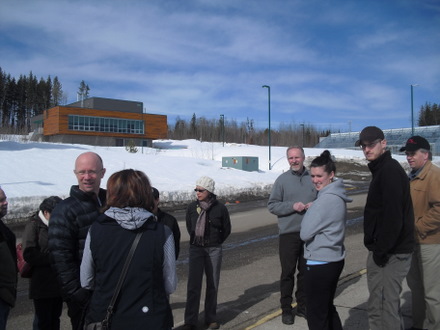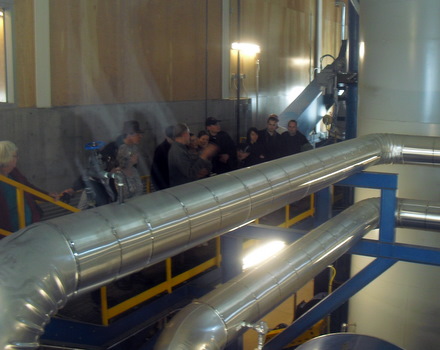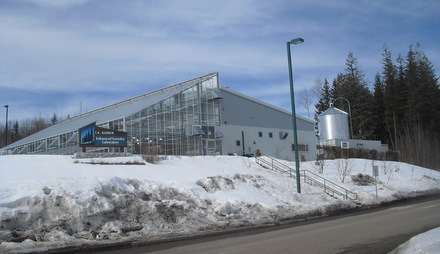Bioenergy Plant Takes UNBC A Deeper Shade Of Green

One of four guided tours through UNBC's new bioenergy plant on weekend
Prince George, B.C. - The day after a ribbon-cutting ceremony that saw Premier Christy Clark officially open UNBC's new $15.7-million dollar bioenergy plant, university officials were giving city residents a first-hand look at the cutting-edge facility.
The plant, funded by the federal and provincial governments, is the university's first facility certified to meet the international Leadership in Energy and Environmental Design (LEED) Gold standard. And it is on that 'high' foundation, plans for the thermal heating plant sit. The 1400m2 building houses the fully automated gasification technology, a control room and research laboratory.
 The projection is the bioenergy plant will use six-thousand bone dry tonnes of wood waste per year from Lakeland Mills on River Road. Right now, it's going through between one to two truckloads of wet hog fuel (22-thousand to 25-thousand kilograms) in a 24-hour period. (click on photo at right to see video clip from inside plant)
The projection is the bioenergy plant will use six-thousand bone dry tonnes of wood waste per year from Lakeland Mills on River Road. Right now, it's going through between one to two truckloads of wet hog fuel (22-thousand to 25-thousand kilograms) in a 24-hour period. (click on photo at right to see video clip from inside plant)
In describing how the system works, UNBC's Assistant Director of Facilities and Capital Projects, Doug Carter, says the plant takes traditional wood combustion and breaks it into three components:
- in the first phase, the wood fibre is piled on top of a smoldering fire in the gasifier - it's subjected to high heat, but starved of oxygen so it starts producing tar, creosote and other volatile gases (the syngas);
- in the second phase, the syngas moves to an oxidizer where oxygen is added and the gas hits between 1400 and 1600 oF and ignites. Carter says this is a very hot, efficient clean burn that is pellet-stove clean in terms of emissions. The gases hit 2000 oF and goes through a boiler where the thermal energy heats water circulating on a loop from the power plant - it leaves at 240oF and comes back at 200oF to be heated once again.
- in phase three, after transferring most of its heat to the water, the syngas moves into an electrostatic precipitator where most of the particulate is taken out. Once cleaned, the air is vented out of the building with emissions comparable to the low-end of natural gas
"We said at the beginning, this would be one of the cleanest - if not, the cleanest - systems in North America and we've achieved that already," says Carter. During testing in January and February, four EPA standard tests were conducted and Carter says the system is marginally below natural gas levels of particulates at 5.27 milligrams per standard cubic metre. "This is a very clean system."
 The world-leading plant is phase two of UNBC's bioenergy plan. Phase one saw a pellet plant built in May of 2009, using wood biomass to heat the 10-thousand square foot enhanced forestry lab. (photo at right) Phase three could involve electricity production - the capabability is there...
The world-leading plant is phase two of UNBC's bioenergy plan. Phase one saw a pellet plant built in May of 2009, using wood biomass to heat the 10-thousand square foot enhanced forestry lab. (photo at right) Phase three could involve electricity production - the capabability is there...
The new bioenergy plant is designed for co-generation - the switches are already in place and the plant is a mere 100-yards from a hydro transmission line - so UNBC could put it back into the grid or generate for its own purposes.
"We're looking at our options," Carter says. "At this point, this is the technology we chose and we're working it through and it's working very well for us - it's very clean and we're now going into operating mode and we're starting to look at our options for other renewable energies and we might be able to go with a syngas technology for power generation (or) we could look at other things, as well." One other possible option could be traditional steam generation.
In the interim, the Assistant Director for Facilities says this new thermal heating plant is designed to do 100-percent of the heating on-campus down to -12oC or so, below that the power plant will have to supplement with natural gas. "So our calculations are - and we're not going to know this for a year, that we should be able to displace up to 85-percent of the natural gas that (the four) boilers in the plan would have consumed with wood biomass."
Carter attended Friday night's Alumni dinner where UNBC Chancellor John MacDonald told the crowd that UNBC has the capacity to be a global leader in renewable energy and, Carter says, these projects are step one.
Previous Story - Next Story
Return to Home











Must be quite a heat loss with all those pretty windows. Poor nothern design to begin with.
I found it interesting the university had a green day and where counting the number of cars. Am I the only one that sees the stupidity of that. The joint was built up a hill, how else is one going to get there, in a 3/4 empty bus. The brainwashed dogma continues.